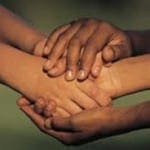 20 years after the genocide in Rwanda, reconciliation still happens one encounter at a time.
20 years after the genocide in Rwanda, reconciliation still happens one encounter at a time.
The New York Times offers a photographic essay of victim and aggressor.
“Last month, the photographer Pieter Hugo went to southern Rwanda, two decades after nearly a million people were killed during the country’s genocide, and captured a series of unlikely, almost unthinkable tableaus. In one, a woman rests her hand on the shoulder of the man who killed her father and brothers. In another, a woman poses with a casually reclining man who looted her property and whose father helped murder her husband and children. In many of these photos, there is little evident warmth between the pairs, and yet there they are, together. In each, the perpetrator is a Hutu who was granted pardon by the Tutsi survivor of his crime.
The people who agreed to be photographed are part of a continuing national effort toward reconciliation and worked closely with AMI (Association Modeste et Innocent), a nonprofit organization. In AMI’s program, small groups of Hutus and Tutsis are counseled over many months, culminating in the perpetrator’s formal request for forgiveness. If forgiveness is granted by the survivor, the perpetrator and his family and friends typically bring a basket of offerings, usually food and sorghum or banana beer. The accord is sealed with song and dance.
The photographs on the following pages are a small selection of a larger body on display — outdoors, in large format — starting this month in The Hague. The series was commissioned by Creative Court, an arts organization based there, as part of “Rwanda 20 Years,” a program exploring the theme of forgiveness. The images will eventually be shown at memorials and churches in Rwanda.
At the photo shoots, Hugo said, the relationships between the victims and the perpetrators varied widely. Some pairs showed up and sat easily together, chatting about village gossip. Others arrived willing to be photographed but unable to go much further. “There’s clearly different degrees of forgiveness,” Hugo said. “In the photographs, the distance or closeness you see is pretty accurate.”
In interviews conducted by AMI and Creative Court for the project, the subjects spoke of the pardoning process as an important step toward improving their lives. “These people can’t go anywhere else — they have to make peace,” Hugo explained. “Forgiveness is not born out of some airy-fairy sense of benevolence. It’s more out of a survival instinct.” Yet the practical necessity of reconciliation does not detract from the emotional strength required of these Rwandans to forge it — or to be photographed, for that matter, side by side.
Photographic essay of victim and aggressor
Tags: Lent, New York TImes, reconciliation, Rwanda


powerful!!!!!